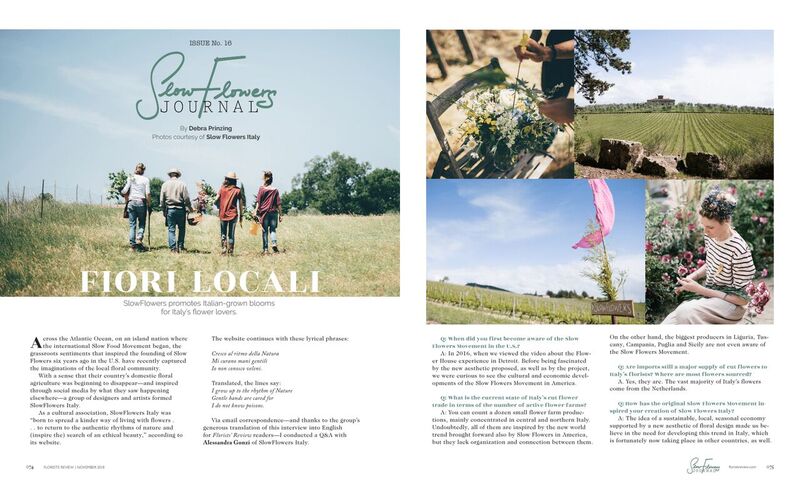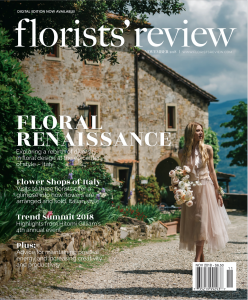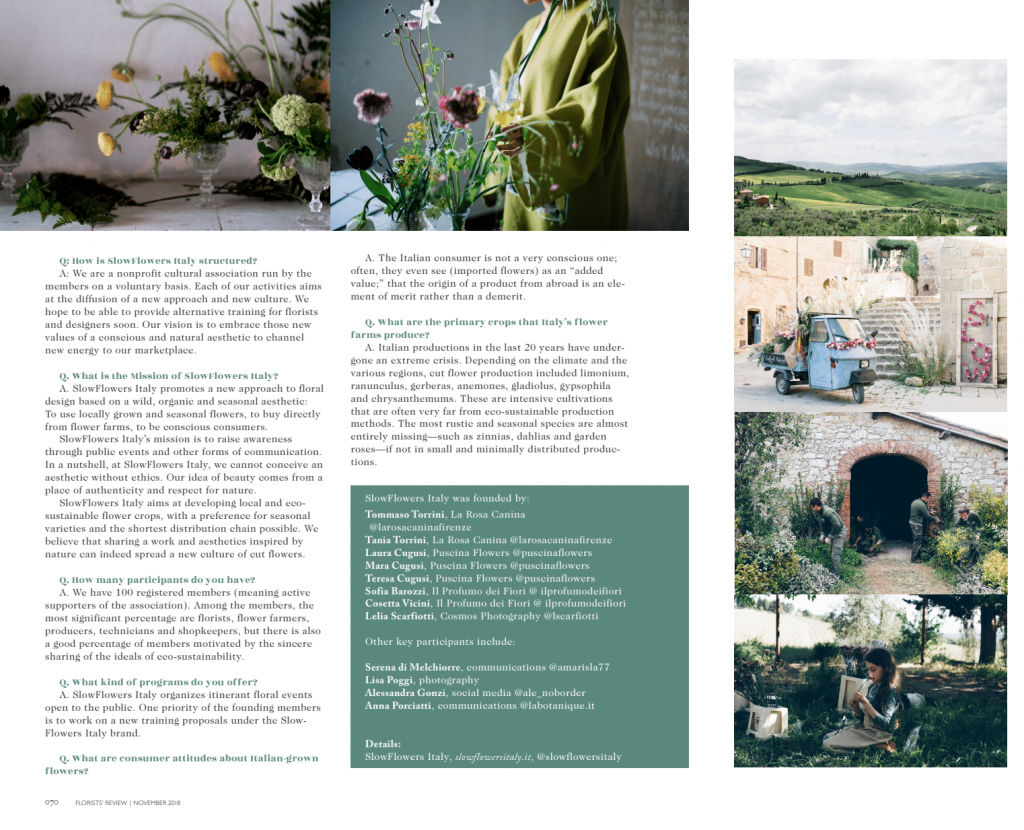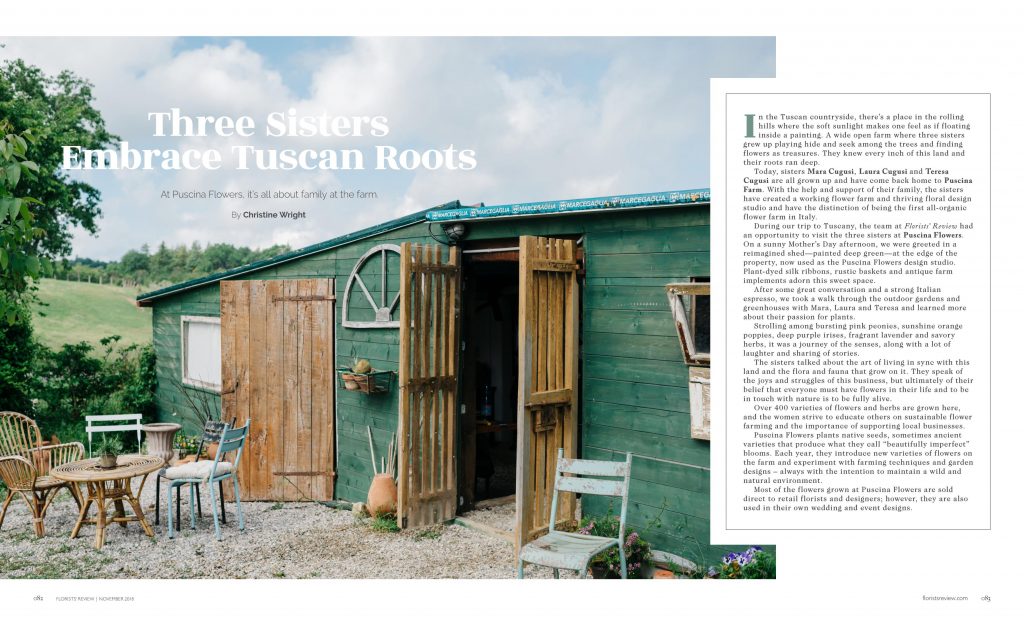
Download Fiori Locali PDF here.
Fiori locali: Promoting Italian-grown blooms for Italy’s flower lovers
By Debra Prinzing; Photography courtesy SlowFlowers Italy
 Across the Atlantic Ocean, on an island nation where the international Slow Food Movement began, the grassroots sentiments that inspired the founding of Slow Flowers six years ago in the U.S. have recently captured the imaginations of the local floral community.
Across the Atlantic Ocean, on an island nation where the international Slow Food Movement began, the grassroots sentiments that inspired the founding of Slow Flowers six years ago in the U.S. have recently captured the imaginations of the local floral community.
With a sense that their country’s domestic floral agriculture was beginning to disappear, and inspired through social media by what they saw happening elsewhere, a group of designers and artists formed SlowFlowers Italy.
As a cultural association, SlowFlowers Italy was “born to spread a kinder way of living with flowers . . . to return to the authentic rhythms of nature, and (inspire the) search of an ethical beauty,” according to its web site.
The web site continues with these lyrical phrases:
Cresco al ritmo della Natura
Mi curano mani gentili
Io non conosco veleni
Translated, the lines say:
I grow up to the rhythm of Nature
Gentle hands are cared for
I do not know poisons
Via email correspondence, and thanks to the group’s generous translation of this interview into English for Florists’ Review readers, I conducted a Q&A with SlowFlowers Italy’s Alessandra Gonzi:
Q: When did you first become aware of the Slow Flowers Movement in the U.S.?
A: In 2016, when we viewed the video about the Flower House experience in Detroit. Before being fascinated by the new aesthetic proposed, as well as by the project, we were curious to see the cultural and economic developments of the Slow Flowers Movement in America.
Q: What is the current state of Italy’s cut flower trade in terms of the number of active flower farms?
A: You can count a dozen of small flower farm productions, mainly concentrated in central and northern Italy. Undoubtedly, all of them are inspired by the new world trend brought forward also by Slow Flowers in America, but they lack organization and connection between them. On the other hand, the biggest producers in Liguria, Tuscany, Campania, Puglia and Sicily are not even aware of the Slow Flowers Movement.
Q: Are imports still a major supply of cut flowers to Italy’s florists? Where are most flowers sourced?
A. Yes, they are. The vast majority of Italy’s flowers come from the Netherlands.
 Q: How has the original Slow Flowers Movement inspired your creation of Slow Flowers Italy?
Q: How has the original Slow Flowers Movement inspired your creation of Slow Flowers Italy?
A: The idea of a sustainable, local, seasonal economy supported by a new aesthetic of floral design made us believe in the need for developing this trend in Italy, which is fortunately now taking place in other countries, as well.
Q: How is SlowFlowers Italy structured?
A: We are a nonprofit cultural association run by the members on a voluntary basis. Each of our activities aims at the diffusion of a new approach, new culture, and we hope soon to be able to provide alternative training for florists and designers. Our vision is to embrace those new values of a conscious and natural aesthetic to channel new energy to our marketplace.
Q: What is the Mission of SlowFlowers Italy?
A. SlowFlowers Italy promotes a new approach to floral design based on a wild, organic and seasonal aesthetic: To use locally-grown and seasonal flowers, to buy directly from flower farms, to be conscious consumers.
SlowFlowers Italy’s mission is to raise awareness through public events and other forms of communication. In a nutshell, at SlowFlowers Italy, we cannot conceive an aesthetic without ethics. Our idea of beauty comes from a place of authenticity and respect for nature.
SlowFlowers Italy aims at developing local and eco-sustainable flower crops, with a preference for seasonal varieties and the shortest distribution chain possible. We believe that sharing a work and aesthetics inspired by nature can indeed spread a new culture of cut flowers.
Q: How many participants do you have?
A. We have 100 registered members (meaning active supporters of the association). Among the members, the most significant percentage are florists, flower farmers, producers, technicians and shopkeepers, but there is also a good percentage of members motivated by the sincere sharing of the ideals of eco-sustainability.
Q: What kind of programs do you offer?
A. SlowFlowers Italy organizes itinerant floral events open to the public. One priority of the founding members is to work on a new training proposals under the SlowFlowers Italy brand.
Q: What are consumer attitudes about Italian-grown flowers?
A. The Italian consumer is not a very conscious one; often, they even see (imported flowers) as an ‘added value’; that the origin of a product from abroad is an element of merit rather than a demerit.
Q: What are the primary crops that Italy’s flower farms produce?
A. Italian productions in the last 20 years have undergone an extreme crisis. Depending on the climate and the various regions, cut flower production included limonium, ranunculus, gerberas, anemones, gladiolus, gypsophila and chrysanthemums. These are intensive cultivations that are often very far from eco-sustainable production methods. The most rustic and seasonal species are almost entirely missing, such as zinnias, dahlias and garden roses, if not in small and minimally distributed productions.
SlowFlowers Italy was founded by:
Tommaso Torrini, La Rosa Canina @larosacaninafirenze
Tania Torrini, La Rosa Canina @larosacaninafirenze
Laura Cugusi, Puscina Flowers @puscinaflowers
Mara Cugusi, Puscina Flowers @puscinaflowers
Teresa Cugusi, Puscina Flowers @puscinaflowers
Sofia Barozzi, Il Profumo Dei Fiori @ ilprofumodeifiori
Cosetta Vicini, Il Profumo Dei Fiori @ ilprofumodeifiori
Lelia Scarfiotti, Cosmos Photography @lscarfiotti
Other key participants include:
Serena di Melchiorre, communications @amarisla77
Lisa Poggi, photography
Alessandra Gonzi, social media @ale_noborder
Anna Porciatti, communications @labotanique.it
Details:
SlowFlowers Italy, slowflowersitaly.it, @slowflowersitaly
Three Sisters Embrace Tuscan Roots
by Christine Wright, photos by Amanda Dumouchelle
 Download Three Sisters PDF here.
Download Three Sisters PDF here.
Slow Flowers LLC launches SLOW FLOWERS INTERNATIONAL

